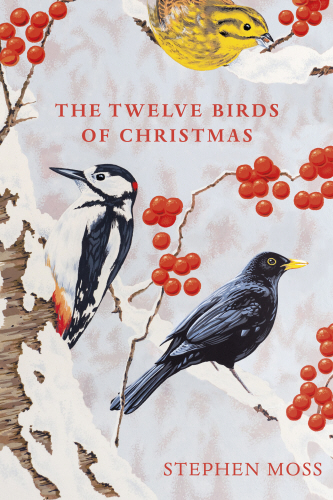The Twelve Birds of Christmas - Stephen Moss
Review by Nathan Hood
‘The Twelve Days of Christmas’ is one of the most popular Christmas carols. Going back several hundred years, it formed a party game, where those taking part would have to try and remember the lines in the song as the verses grow longer until someone forfeits. The gifts given have been a cause of fascination, with many of them fitting well with Yuletide festivities, feasting and merrymaking. Many authors have seen a hidden meaning in the lyrics. Some have interpreted it as a secret way for Catholics, persecuted in Elizabethan England, to teach children their doctrines. For others, it is a clue to the weather and fortunes of the months the following year.
Stephen Moss brings a fresh interpretation to this song: that the twelve gifts are all kinds of bird. In his view, they are the partridge, dove, chicken, blackbird, yellowhammer, goose, swan, nightjar, crane, black grouse, sandpiper and woodpecker. The eagle-eyed reader will have noted that several of these birds explicitly feature in the carol, thereby giving a degree of plausibility to Moss’s theory. Additionally, his argument for the inclusion of the yellowhammer or ‘yoldring’ is etymologically compelling. However, the place of the final five is a lot more speculative.
However, The Twelve Days of Christmas is not the focus of this book. Rather, Moss’s aim is to introduce his audience to twelve birds who have a place in the history, culture and life of Great Britain. In an accessible and engaging style, the author shares with enthusiasm the biological existence of these beautiful creatures, describing their eating, nesting, mating and migratory habits. His examination serves to highlight the rich orthinological variety found on this island. We have birds who nest on the ground, birds who live in hedges and trees, birds who live here all year round, birds who migrate thousands of miles every year. Some birds whistle, others make sound by tapping their beaks, others year through flight of their wings.
Moss goes further and discusses the cultural history of these different birds. The Swan, for example, is a creature present in Greek mythology and European fairy tale. Its elegance, beauty and severe temperament lend itself to both feminine grace and masculine lustful savagery. The Nightjar was regularly called the ‘goatsucker’, even by a figure such as Aristotle. It was believed that these birds suckled from goats, robbing the kids of their nourishment and sending their mother’s blind. They were thereby seen as demonic or as the souls of unbaptised children. Moss’s book highlights well the connection between the natural history and cultural legacy of these birds, that the two are intertwined.
Beyond interesting fact, the book has an important message. Due to changes in industrial farming, such as the use of pesticides and damage to hedgerows, some bird populations are in decline. The partridge and the turtle dove, both birds with long histories in England, face extinction. Without changes in our behaviour and concerted efforts to save them, they will disappear forever. While some birds are thriving in our gardens, like the blackbird, too many of their kind cannot survive the changes made by us in our countryside. This is not just a matter of their existence, but the preservation of a living link with our history, traditions and customs. To let them go is to let a part of ourselves pass away too.
In all, this is a great book. Eminently readable, highly informative and a love letter to the avian dimension of Britain. Pick it up, whether yourself or as a gift – it is worth it!


